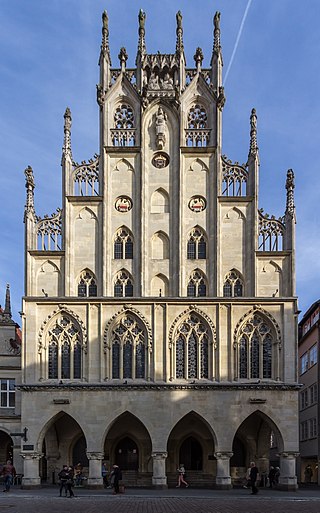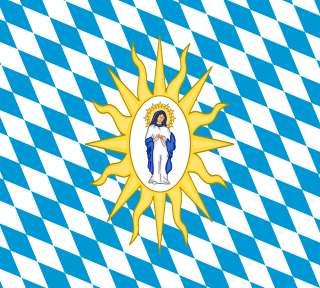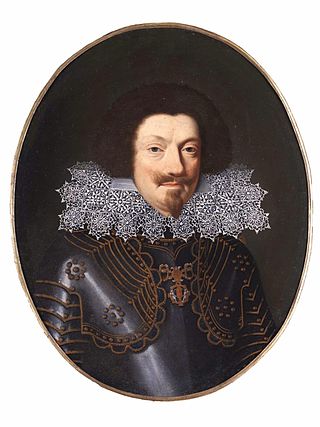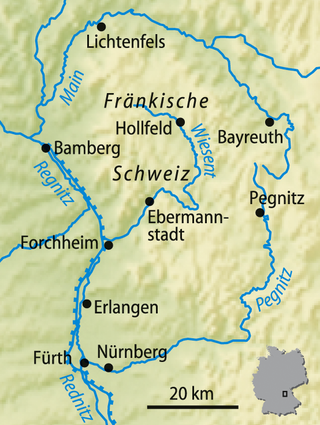
The Peace of Westphalia is the collective name for two peace treaties signed in October 1648 in the Westphalian cities of Osnabrück and Münster. They ended the Thirty Years' War (1618–1648) and brought peace to the Holy Roman Empire, closing a calamitous period of European history that killed approximately eight million people. Holy Roman Emperor Ferdinand III, the kingdoms of France and Sweden, and their respective allies among the princes of the Holy Roman Empire, participated in the treaties.

The Thirty Years' War, from 1618 to 1648, was one of the most destructive conflicts in European history. Fought primarily in Central Europe, an estimated 4.5 to 8 million soldiers and civilians died from the effects of battle, famine, or disease, while parts of Germany reported population declines of over 50%. Related conflicts include the Eighty Years' War, the War of the Mantuan Succession, the Franco-Spanish War, the Torstenson War, the Dutch-Portuguese War, and the Portuguese Restoration War.

1631 (MDCXXXI) was a common year starting on Wednesday of the Gregorian calendar and a common year starting on Saturday of the Julian calendar, the 1631st year of the Common Era (CE) and Anno Domini (AD) designations, the 631st year of the 2nd millennium, the 31st year of the 17th century, and the 2nd year of the 1630s decade. As of the start of 1631, the Gregorian calendar was 10 days ahead of the Julian calendar, which remained in localized use until 1923.

The Battle of Nördlingen, fought over two days from 5 to 6 September 1634, was a major battle of the Thirty Years' War. A Imperial-Spanish force led by the Cardinal-Infante Ferdinand and Ferdinand of Hungary inflicted a crushing defeat on the Swedish-German army led by Gustav Horn and Bernhard of Saxe-Weimar.

Ferdinand II was Holy Roman Emperor, King of Bohemia, Hungary, and Croatia from 1619 until his death in 1637. He was the son of Archduke Charles II of Inner Austria and Maria of Bavaria, who were devout Catholics. In 1590, when Ferdinand was 11 years old, they sent him to study at the Jesuits' college in Ingolstadt because they wanted to isolate him from the Lutheran nobles. A few months later, his father died, and he inherited Inner Austria–Styria, Carinthia, Carniola and smaller provinces. His cousin, Rudolf II, Holy Roman Emperor, who was the head of the Habsburg family, appointed regents to administer these lands.

Frederick V was the Elector Palatine of the Rhine in the Holy Roman Empire from 1610 to 1623, and reigned as King of Bohemia from 1619 to 1620. He was forced to abdicate both roles, and the brevity of his reign in Bohemia earned him the derisive sobriquet "the Winter King".

The Catholic League was a coalition of Catholic states of the Holy Roman Empire formed 10 July 1609. While initially formed as a confederation to act politically to negotiate issues vis-à-vis the Protestant Union, modelled on the more intransigent ultra-Catholic French Catholic League (1576), it was subsequently concluded as a military alliance "for the defence of the Catholic religion and peace within the Empire".

Maximilian I, occasionally called the Great, a member of the House of Wittelsbach, ruled as Duke of Bavaria from 1597. His reign was marked by the Thirty Years' War during which he obtained the title of a prince-elector of the Holy Roman Empire at the 1623 Diet of Regensburg.

John George I was Elector of Saxony from 1611 to 1656. He led Saxony through the Thirty Years' War, which dominated his 45-year reign.

The Peace of Prague, dated 30 May 1635 Old Style, was a significant turning point in the Thirty Years' War. Signed by John George I, Elector of Saxony, and Ferdinand II, Holy Roman Emperor, the terms ended Saxony's support for the anti-Imperial coalition led by Sweden.

The Heilbronn League was formed in the Free Imperial City of Heilbronn, on 23 April 1633, during the Thirty Years' War. Led by Sweden, it brought together various Protestant states in western and northern Germany. It was supported by Saxony and Brandenburg-Prussia, although they were not members.

The Battle of Jankau, also known as Jankov, Jankow, or Jankowitz, took place in central Bohemia on 6 March 1645, near modern Czech town of Jankov. One of the last major battles of the 1618 to 1648 Thirty Years' War, it was fought between Swedish and Imperial armies, each containing around 16,000 men.

The War of the Mantuan Succession (1628–1631) was a conflict related to the Thirty Years' War and was caused by the death in December 1627 of Vincenzo II, the last male heir in the direct line of the House of Gonzaga and the ruler of the duchies of Mantua and Montferrat. Those territories were key to control of the Spanish Road, an overland route that allowed Habsburg Spain to move recruits and supplies from Italy to their army in Flanders. The result was a proxy war between France, which supported the French-born Duke of Nevers, and Spain, which backed a distant cousin, the Duke of Guastalla.

The Electorate of Bavaria was a quasi-independent hereditary electorate of the Holy Roman Empire from 1623 to 1806, when it was succeeded by the Kingdom of Bavaria.

The Battle of Herbsthausen, also known as the Battle of Mergentheim, took place near Bad Mergentheim, in the modern German state of Baden-Württemberg. Fought on 5 May 1645, during the Thirty Years War, it featured a French army led by Turenne, defeated by a Bavarian force under Franz von Mercy.

The Treaty of Bärwalde, signed on 23 January 1631, was an agreement by France to provide Sweden financial support, following its intervention in the Thirty Years' War.
The Diet of Regensburg was a meeting of the Prince-Electors of the Holy Roman Empire which occurred at Regensburg from July to November 1630. It resulted in a major loss of power for the Holy Roman Emperor Ferdinand II.

The Diet of Regensburg of 1623 was a meeting of the Imperial States of the Holy Roman Empire convened by Holy Roman Emperor Ferdinand II. The meeting was not technically an imperial diet in the full sense, but a convention of princes or Deputationstag – a looser constitutional format giving the emperor greater leeway to make decisions without being bound by formal procedures. At the meeting, the Electorate of the Palatinate was transferred to Maximilian I of Bavaria. The meeting marked the high-water mark of imperial power during the Thirty Years' War.

The Battle of Fürth was fought on 3 September 1632 between the Catholic forces of Holy Roman Emperor Ferdinand II and the Protestant forces of King Gustavus II of Sweden during the period of Swedish intervention in the Thirty Years War.
The imperial election of 1653 was an imperial election held to select the emperor of the Holy Roman Empire. It took place in Augsburg on May 31.



















